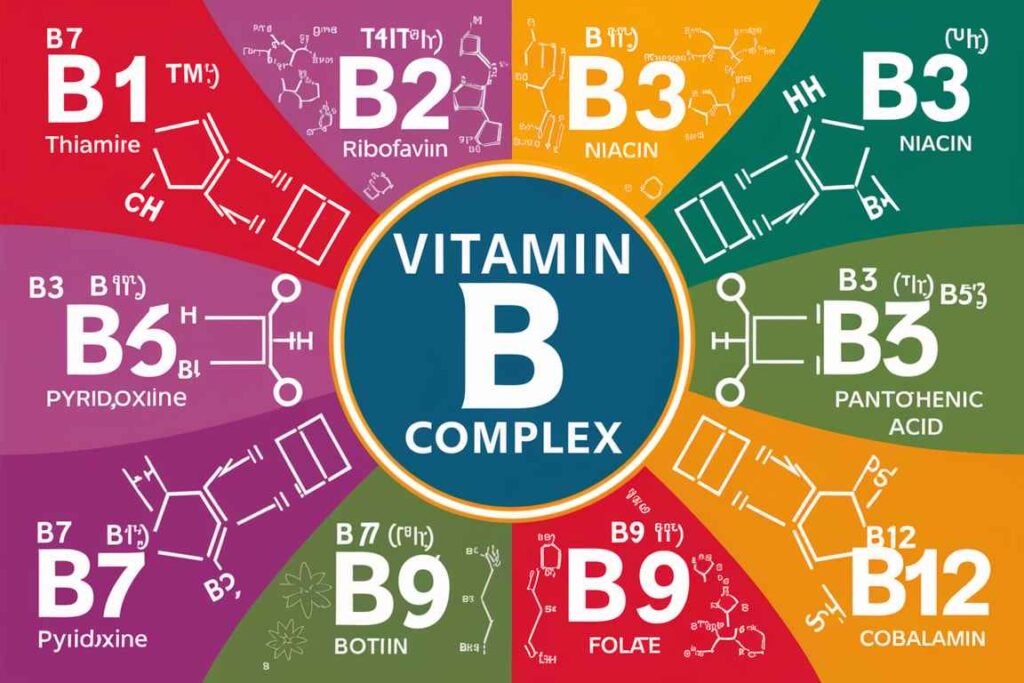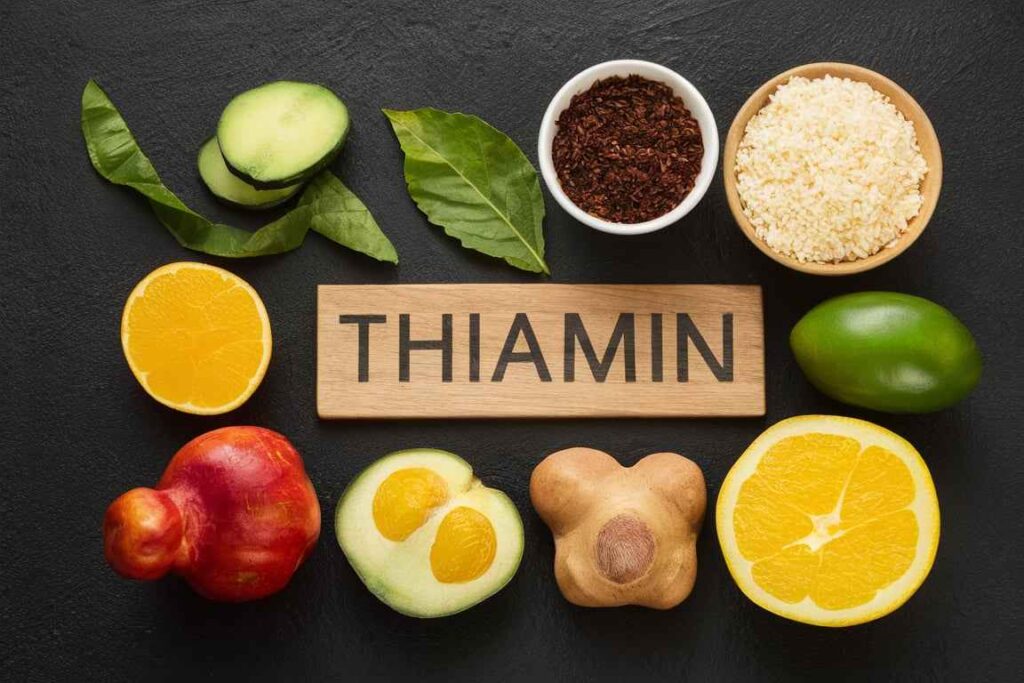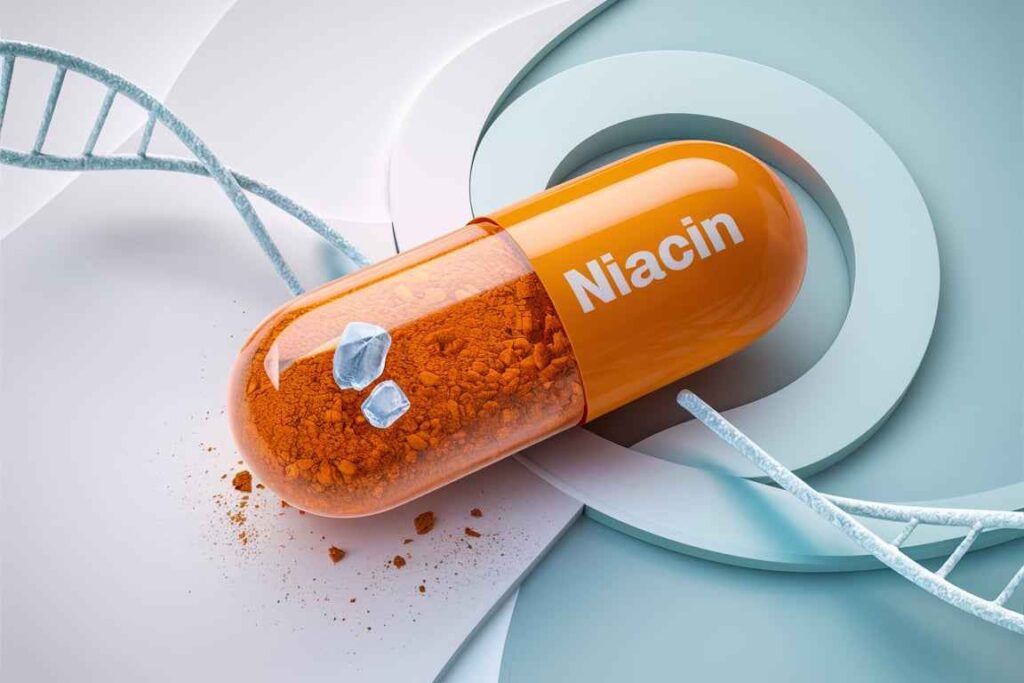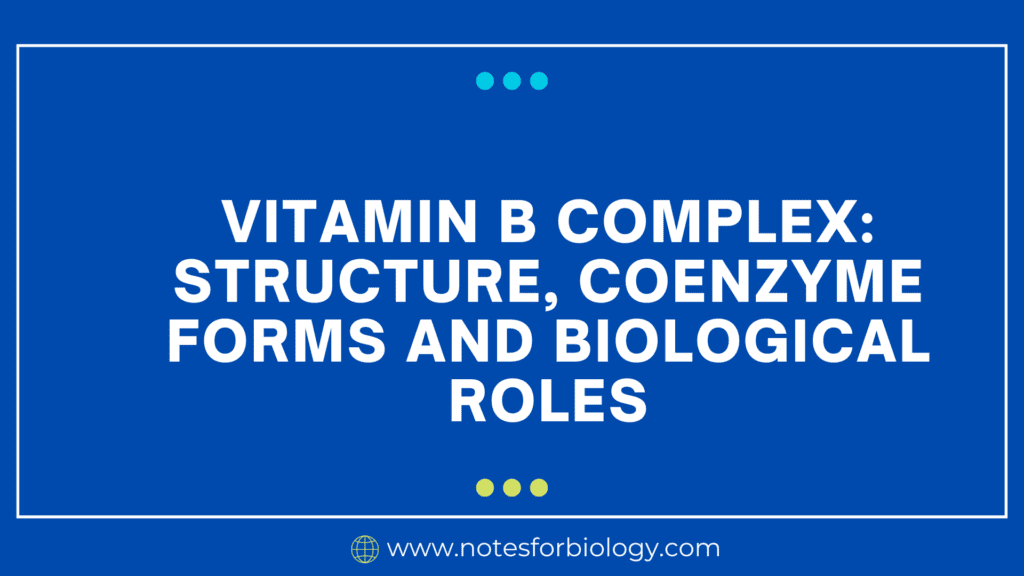Vitamin B complex is a collection of eight water-soluble vitamins that perform critical roles in cellular metabolism and overall physiological function. Vitamin B complex, Each of these vitamins has distinct structures and functions, but they frequently collaborate to sustain a variety of biological functions, such as energy production, red blood cell creation, and the health of the skin, eyes, and nervous system.
Table of Contents
Vitamin B complex
Vitamin B complex is a collection of eight water-soluble vitamins that perform critical roles in cellular metabolism and overall physiological function. Vitamin B complex, Each of these vitamins has distinct structures and functions, but they frequently collaborate to sustain a variety of biological functions, such as energy production, red blood cell creation, and the health of the skin, eyes, and nervous system.

Components of Vitamin B Complex
The Components of Vitamin B complex are given below:
- Vitamin B1 (Thiamine)
- Vitamin B2 (Riboflavin)
- Vitamin B3 (Niacin)
- Vitamin B5 (Pantothenic Acid)
- Vitamin B6 (Pyridoxine)
- Vitamin B7 (Biotin)
- Vitamin B9 (Folate or Folic Acid)
- Vitamin B12 (Cobalamin)
1. Thiamine (Vitamin B1):

- Structure: Imagine a two-part puzzle. One piece is a thiazole ring, resembling a five-membered ring with nitrogen and sulfur atoms. The other is a pyrimidine ring, similar to a six-membered ring with two nitrogen atoms. In thiamine, these rings connect, forming the foundation for its essential functions.
- Coenzyme Form: Thiamine pyrophosphate (TPP) – Picture thiamine with a pyrophosphate group (two phosphate groups linked together) attached. This “activated” form becomes a key player in energy metabolism.
- Biological Roles:
- Energy Powerhouse: TPP participates in breaking down carbohydrates for energy production.
- Nerve Conductor: It supports healthy nerve function, ensuring proper communication throughout the body.
- DNA Blueprint: TPP plays a role in DNA synthesis, the creation of our genetic code.
- Deficiency Woes: A lack of thiamine can lead to beriberi, a neurological disorder characterized by fatigue, muscle weakness, and nerve damage.
2. Riboflavin (Vitamin B2):

- Structure: This vitamin exists in two forms: flavin mononucleotide (FMN) and flavin adenine dinucleotide (FAD). Both share a core structure resembling a bicycle with a central flavin ring (containing nitrogen atoms). FMN has a single phosphate group attached, while FAD boasts an additional adenine nucleotide.
- Coenzyme Forms: FMN and FAD – These modified forms of riboflavin become crucial coenzymes in energy metabolism.
- Biological Roles:
- Energy Chain Reaction: FMN and FAD participate in the electron transport chain, a series of reactions generating cellular energy.
- Cellular Maintenance: They contribute to various cellular functions, ensuring proper cell growth and development.
- Visionary Role: Riboflavin plays a role in maintaining healthy eyesight.
- Deficiency Signs: A lack of riboflavin can manifest as cracks at the corners of the mouth (cheilosis), light sensitivity, and fatigue.
3. Niacin (Vitamin B3):

- Structure: Niacin comes in two forms: nicotinic acid and nicotinamide. Nicotinic acid resembles a simple pyridine ring with a carboxyl group attached. Nicotinamide has an additional amide group, replacing a hydrogen atom with a nitrogen-containing group.
- Coenzyme Forms: Nicotinamide adenine dinucleotide (NAD) and nicotinamide adenine dinucleotide phosphate (NADP) – Both forms of niacin are converted into these essential coenzymes. NAD and NADP differ by the presence of a phosphate group in NADP.
- Biological Roles:
- Energy Conversion: NAD and NADP are vital coenzymes in energy metabolism, helping convert food into usable energy.
- Cellular Communication: They participate in cell signaling processes, allowing cells to communicate and coordinate functions.
- DNA Repair Crew: NAD plays a role in DNA repair, ensuring the integrity of our genetic code.
- Deficiency Issues: A lack of niacin can lead to pellagra, a condition characterized by dermatitis, diarrhea, and dementia.
4. Pantothenic Acid (Vitamin B5):
- Structure: Imagine a complex molecule formed by the union of pantothenic acid (containing a β-alanine and a β-mercaptoethylamine group) and cysteine (an amino acid). This intricate structure paves the way for its diverse functions.
- Coenzyme Form: Coenzyme A (CoA) – Pantothenic acid undergoes a series of transformations to become CoA, a crucial coenzyme in numerous metabolic pathways.
- Biological Roles:
- Metabolic Maestro: CoA acts as a carrier molecule, transporting essential components within cells for energy production from carbohydrates and fats.
- Cholesterol Conductor: It plays a role in cholesterol synthesis, a vital component of cell membranes and hormone production.
- Energy from Everywhere: CoA also participates in breaking down fatty acids and converting them into energy.
- Deficiency Rarity: While uncommon, pantothenic acid deficiency can cause fatigue, muscle cramps, and burning feet.
5. Pyridoxine (Vitamin B6):
- Structure: Pyridoxine comes in three forms: pyridoxine, pyridoxal, and pyridoxamine. All share a similar core structure with a pyridine ring and a hydroxyl group attached. They differ in the functional groups present.
- Coenzyme Form: Pyridoxal phosphate (PLP) – Pyridoxal, after undergoing a transformation, becomes PLP, the active coenzyme form of vitamin B6.
- Biological Roles:
- Protein Powerhouse: PLP plays a critical role in amino acid metabolism, the building blocks of proteins. It aids in their breakdown, synthesis, and conversion into other essential molecules.
- Red Blood Cell Factory: It supports red blood cell formation, ensuring proper oxygen delivery throughout the body.
- Neurotransmitter Maestro: PLP is involved in the production of neurotransmitters, chemicals enabling communication between nerve cells.
- Deficiency Dangers: A lack of pyridoxine can lead to nerve damage, anemia, and skin problems.
6. Biotin (Vitamin B7):
- Structure: This small but mighty vitamin boasts a unique structure with a ureido ring (containing nitrogen and oxygen atoms) linked to a tetralinoid ring (resembling a four-ringed hydrocarbon).
- Coenzyme Form: Biotin itself acts as the coenzyme. Unlike other B vitamins, it doesn’t require further modifications.
- Biological Roles:
- Metabolic Marvel: Biotin is a key player in carbohydrate, fat, and protein metabolism, ensuring the body efficiently utilizes these nutrients for energy and building blocks.
- Cellular Communication: It participates in cell signaling pathways, allowing cells to communicate and regulate various functions.
- Gene Expression: Biotin plays a role in gene expression, controlling which genes are turned on or off in a cell.
- Deficiency Rarity: Similar to pantothenic acid, biotin deficiency is uncommon but can cause hair loss, scaly skin, and fatigue.
7. Folate (Vitamin B9):
- Structure: Imagine a complex molecule with a pteridine ring (containing nitrogen atoms) linked to para-aminobenzoic acid (PABA) and glutamic acid residues. This intricate structure allows folate to perform its vital functions.
- Coenzyme Forms: Tetrahydrofolate (THF) and its derivatives – Folate undergoes a series of conversions to become THF, the active coenzyme form. THF has various derivatives with specific functions.
- Biological Roles:
- DNA Duplication Duo: THF and its derivatives are essential for DNA synthesis and repair, ensuring accurate duplication of our genetic code.
- Amino Acid Architect: They participate in amino acid metabolism, allowing for the creation of new proteins and the breakdown of old ones.
- Red Blood Cell Production: Folate plays a crucial role in red blood cell formation, preventing anemia.
- Deficiency Risks: A lack of folate can lead to neural tube defects in fetuses, anemia, and fatigue.
8. Cobalamin (Vitamin B12):
- Structure: The most complex B vitamin, cobalamin boasts a central cobalt atom surrounded by a corrin ring (similar to a porphyrin ring in heme). This unique structure allows it to bind to essential molecules.
- Coenzyme Forms: Methylcobalamin and adenosylcobalamin – Cobalamin undergoes modifications to become these two coenzyme forms, each with distinct functions.
- Biological Roles:
- Nerve Conductor: Methylcobalamin plays a crucial role in maintaining healthy nerve function, ensuring proper communication throughout the body.
- DNA Replication Regulator: Adenosylcobalamin participates in DNA synthesis and regulation, ensuring accurate cell division.
- Red Blood Cell Formation: Cobalamin is essential for red blood cell production, preventing anemia.
- Deficiency Dangers: A lack of cobalamin can lead to nerve damage, anemia, and fatigue.
Frequently Asked Question
What is Vitamin B complex ?
Vitamin B complex is a collection of eight water-soluble vitamins that perform critical roles in cellular metabolism and overall physiological function. Vitamin B complex, Each of these vitamins has distinct structures and functions, but they frequently collaborate to sustain a variety of biological functions, such as energy production, red blood cell creation, and the health of the skin, eyes, and nervous system.
What are the components of Vitamin B Complex ?
The components of Vitamin B Complex are
1. Vitamin B1 (Thiamine)
2. Vitamin B2 (Riboflavin)
3. Vitamin B3 (Niacin)
4. Vitamin B5 (Pantothenic Acid)
5. Vitamin B6 (Pyridoxine)
6. Vitamin B7 (Biotin)
7. Vitamin B9 (Folate or Folic Acid)
8. Vitamin B12 (Cobalamin)
Related Article

